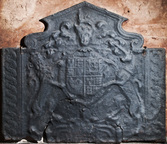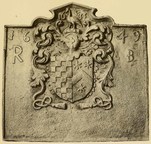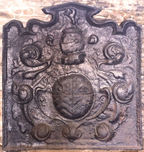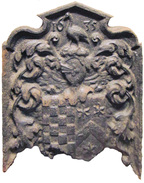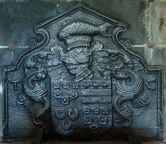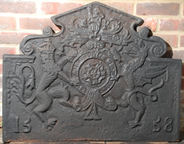-
1319
Description: Rectangular with pediment raised on inverted consoles; fillet edging, ovolo-moulded in the pediment; shield, garter, helm, mantling, crest of a lion surmounting a chapeau, and motto cartouche with obliterated text; on each side, an extension panel with a vertical guilloche pattern.
Notes: One of several firebacks, all varying in size, framing style and moulding, with stylistic features in common and almost certainly the work of the same pattern maker, who was also responsible for carving royal coats of arms in several West Country churches. The presence of the chapeau, or Cap of Maintenance, is unusual on arms of this period, it being more common on medieval achievements.
Copies of this fireback are known.
Arms: English Stuart royal
- Decoration tags:
- rectangular with detached pediment (shape)
- fillet (edging)
- whole carved pattern
- extension panels
- heraldic
- armorial
- royal
Manufactured: in the early-17th century in England.
Current location: Barnstaple Guildhall, Butchers Row, Barnstaple, Devon, England.
- Attached to series:
- Bristol armorial group
- Stuart royal armorial firebacks
-
831
Description: Rectangular with small detached pediment; cavetto-moulded edging; upper centre, shield, helm, crest and mantling, with date, 1635, split either side of crest; top, date, 1649, split either side of armorial; initials split either side of armorial, below date.
Notes: The armorial, tentatively associated with the family of Brooke or Broke of Madeley, Shropshire (blazon: chequy argent and sable, impaling a chevron between three estoiles), dated 1635, was formed from a pattern designed for a smaller fireback (see no. 917), but positioned on a larger backing board with the later date and initials added separately, most of the frame of the original fireback being pared away. From an illustration in the catalogue of an exhibition on heraldry at Burlington House, London, in 1894.
Inscription: 16 35 / 16 49 / R B
Arms: poss. Brooke or Broke of Staffordshire
- Decoration tags:
- rectangular with detached pediment (shape)
- cavetto (edging)
- carved stamps
- carved pattern panels
- composite
- individual letters
- individual numbers
- armorial
- text
Manufactured: in 1649 in England.
Current location: not known.
- Attached to series:
- Personal armorial firebacks
- Composite firebacks
-
28
Description: Rectangular with pediment raised on inverted consoles; ovolo, egg and dart edging; shield, garter, helm, mantling, crest and motto of the English House of Stuart; date split either side of garter buckle.
Notes: One of several firebacks, all of the same date, but varying in size, framing style and moulding; all have stylistic features in common and will have been the work of the same pattern maker, who was also responsible for carving royal coats of arms in three West Country churches.
Copies of this fireback are known.
Inscription: HONY SOIT QVI MAL Y PENSE / 16 18 / DIEV ET MON DROIT
Arms: English Stuart royal (James I)
- Decoration tags:
- rectangular with detached pediment (shape)
- ovolo, egg and dart (edging)
- whole carved pattern
- armorial
- royal
- text
Manufactured: in 1618 possibly in the Forest of Dean area of England.
Current location: Bateman's, Burwash, East Sussex, England.
Museum number: 761132 (part of the National Trust museum group)
-
916
Description: Rectangular, with a detached pediment joined by rebated scrolls; cavetto-moulded edging; circular 'shield' in a cartouche, surmounted by an esquire's helm and lion rampant crest, with mantling behind; initials split by crest; date split in top corners.
Notes: The armorial is of David Prichard (d. 1630) of Llancaiac Fawr Manor; the blazon follows the patriarchal tradition of Welsh heraldry: quarterly, 1st, Sable a lion rampant Argent (for Cydrych ap Gwaithfoed), 2nd, Sable a chevron between three fleurs de lys Argent (for Einion ap Gollwyn), 3rd, Gules three chevrons Argent (for Iestyn ap Gwrgan), and 4th, Sable a chevron between three spear-heads Argent (for Bleddyn ap Maenyrch); the '8' of the date has a flattened top. A copy, from a broken original.
Inscription: D P / 16 28
Arms: Prichard (or ap Richard)
- Decoration tags:
- rectangular with detached pediment (shape)
- cavetto (edging)
- whole carved pattern
- armorial
- text
Manufactured: in 1628 possibly at Dyffryn Furnace in the South Wales area of Wales.
Current location: Llancaiach Fawr Manor, Nelson, Caerphilly, Glamorgan, Wales.
Museum number: GTJ75111 (part of the Caerphilly County Borough Council Museums & Heritage Service museum group)
- Attached to series:
- Personal armorial firebacks
- Welsh armorial firebacks
-
917
Description: Rectangular with detached pediment joined by S-curves; cavetto-moulded edging; shield, helm, bird crest and mantling, with date, 1635, split either side of crest; bottom of casting missing due to corrosion.
Notes: Tentatively identified as the arms of Brooke or Broke of Lapley, Staffordshire (blazon: chequy argent and sable, impaling a chevron between three estoiles); this fireback, or its pattern, have been used as a stamp on another fireback with a later date and initials added separately (see no. 831).
Inscription: 16 35
Arms: poss. Brooke of Staffordshire
- Decoration tags:
- rectangular with detached pediment (shape)
- cavetto (edging)
- whole carved pattern
- armorial
- text
Manufactured: in 1635 in England.
Current location: The Museum of Cambridge, 2/3 Castle Street, Cambridge, Cambridgeshire, England.
(part of the The Museum of Cambridge museum group)
- Attached to series:
- Personal armorial firebacks
-
857
Description: Rectangular with detached pediment linked by S-curves, protruding from each of which is a small scroll; cavetto-moulded edging (top and sides); quartered shield with helm, crest and mantling; initials in top corners.
Notes: The arms are of Sir Julius Caesar (1558-1636), judge and politician, Chancellor of the Exchequer 1606-13. Blazon: Quarterly, 1st and 4th, Gules, three roses argent, on a chief of the second three roses of the first (Caesar); 2nd, argent, two bars sable, on a chief of the second three swans of the first (?Martin); 3rd, gules, three crescents argent (Peryent/Perin). Crest: a dolphin embowed in the sea vert. This example has the additional initials, TC. The style of the carving is the same as on two other firebacks in the same county.
Copies of this fireback are known.
Inscription: T C
Arms: Caesar
- Decoration tags:
- rectangular with detached pediment (shape)
- cavetto (edging)
- whole carved pattern
- individual letters
- planklines
- armorial
- text
Manufactured: in the early-17th century possibly in the Herefordshire area of England.
Current location: Croft Castle, Yarpole, Herefordshire, England.
Museum number: 537532 (part of the National Trust museum group)
- Attached to series:
- Personal armorial firebacks
- Loop edged firebacks
- Herefordshire armorial series
-
355
Description: Rectangular joined to pediment by symmetrical scrolls; fillet edging with embattling inside; shield, helm, crest, supporters and mantling of the city of Bristol; date split by bottom of shield; inscription in an oval cartouche below shield.
Notes: Both '3's in the date are a substitution, with another casting suggesting an original date of 1614 or 1624. The pattern-maker was also responsible for carving royal coats of arms in three West Country churches and a small number of series of firebacks in the first quarter of the 17th century. A variant with side extension panels is no. 952.
Copies of this fireback are known.
Inscription: 16 33 / [ARMES] BRISTOLL
Arms: City of Bristol
- Decoration tags:
- rectangular with detached pediment (shape)
- fillet (edging)
- whole carved pattern
- individual numbers
- armorial
- text
Manufactured: in 1633 possibly in the Forest of Dean area of England.
Current location: Kenilworth Castle, Kenilworth, Warwickshire, England.
Museum number: 88278827 (part of the English Heritage museum group)
- Attached to series:
- Civic firebacks
- Bristol armorial group
-
976
 ? x ? mm
? x ? mmDescription: Plain rectangular plate with detached pediment; central shield with motto scroll below.
Notes: The severe classical form suggests that this back may have been intended for attaching to a grate. Blazon: Tynte - Gules, a lion couchant between six cross-crosslets Argent; Kemeys - Vert, on a chevron Argent three pheons Sable.
Inscription: DYW DY RAS
Arms: Tynte quartering Kemeys
- Decoration tags:
- rectangular with detached pediment (shape)
- none (edging)
- whole carved pattern
- armorial
Manufactured: in the 18th century in Wales.
Current location: Cefnmabli, Rudry, Glamorgan, Wales.
- Attached to series:
- Personal armorial firebacks
-
682
Description: Rectangular, with detached pediment joined by mirrored S-shaped scrolls; fillet edging with scalloping on inside edge (top and sides of rectangle, and pediment, only); central Tudor rose with surrounding garter, crowned lion and dragon supporters, surmounted by a helmet, mantling and crowned lion passant crest; initials, ER, separated by crest; initials, TP, in top corners of rectangle; ‘date’ split between bottom corners.
Notes: Stylistically of the late 16th or very early 17th centuries, the date is absent from some versions, and is likely to have been added spuriously to later recastings, of which this is one, the style of the numerals being identical to a series of firebacks cast in 1648-58.
Copies of this fireback are known.
Inscription: E R / T P / 1558
- Decoration tags:
- rectangular with detached pediment (shape)
- scalloped fillet (edging)
- whole carved pattern
- individual numbers
- heraldic
- royal
- text
Manufactured: in the mid-17th century possibly at Tintern Furnace in the Forest of Dean area of Wales.
Current location: in private hands, Sedlescombe, East Sussex, England.
- Attached to series:
- Miscellaneous royal firebacks
- 1640-50s Dean series
-
692
Description: Rectangular with inclined sides, joined by scrolls to a pedimented top; twisted rope edging (top and sides); Garter enclosing the Tudor royal arms, with crowned lion and dragon supporters, helm with chapeau and lion crest, and mantling; rectangular date compartment at base; initials either side of crest.
Notes: The detached pediment is stylistically typical of the late-16th and early-17th centuries. The use of a chapeau or cap of maintenance in place of a crown above the helm is rare in this period. There is an excrescence on the casting over the jaws of the dragon caused by the pouring of the molten metal disturbing the sand mould.
Inscription: E R / Garter motto / 160[?0]
Arms: Tudor royal - Elizabeth I
- Decoration tags:
- rectangular with detached pediment (shape)
- rope (edging)
- whole carved pattern
- individual letters
- individual numbers
- armorial
- royal
- text
Manufactured: in 1600 in England.
Current location: Cothay Manor, Stawley, Somerset, England.
- Attached to series:
- Elizabethan royal armorial firebacks
- Tudor royal armorial firebacks
